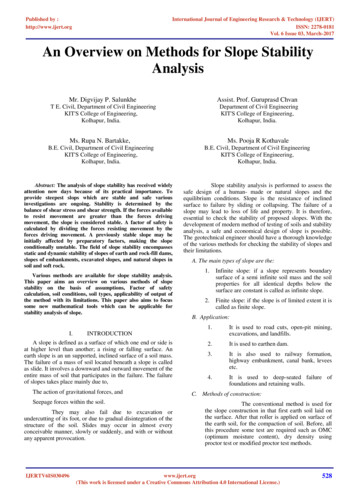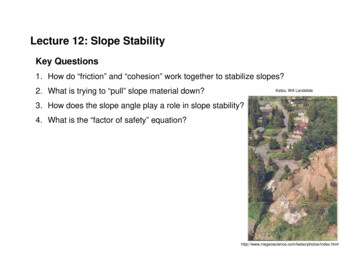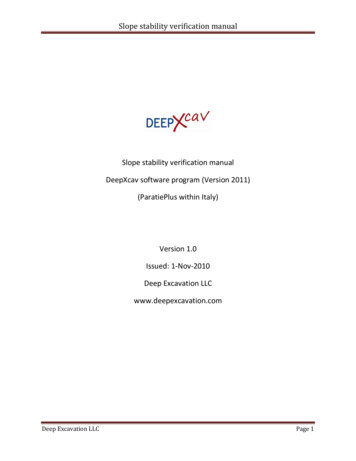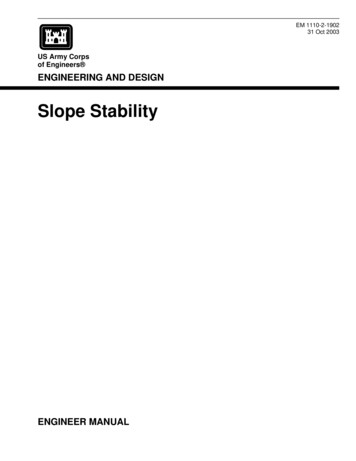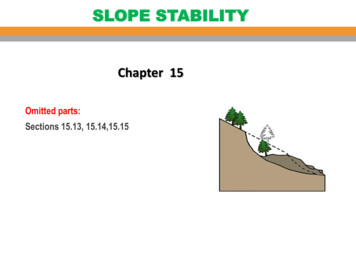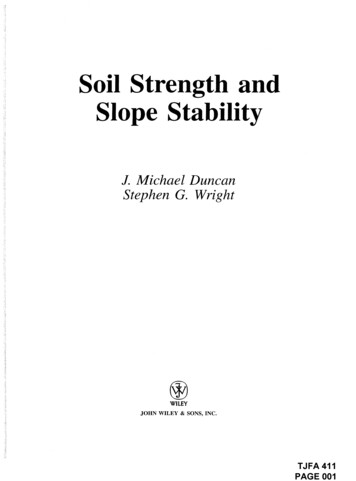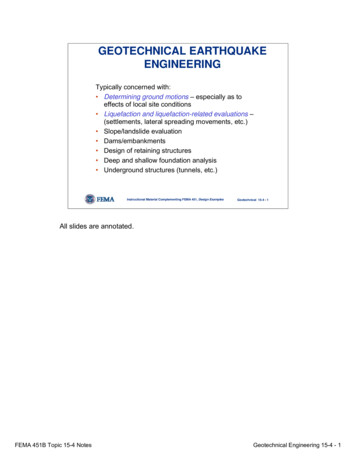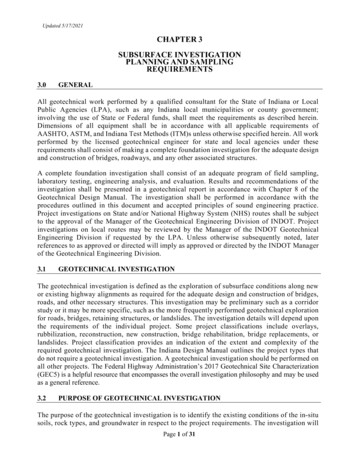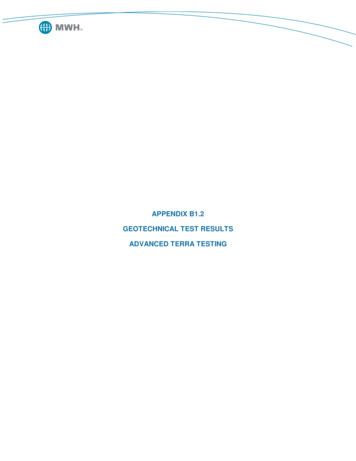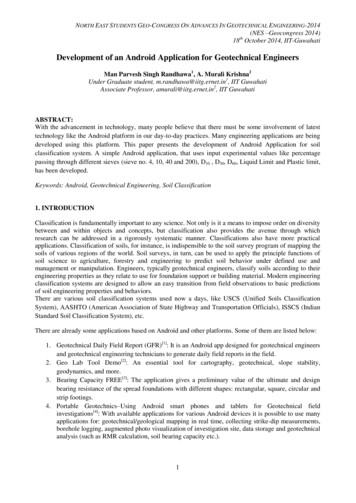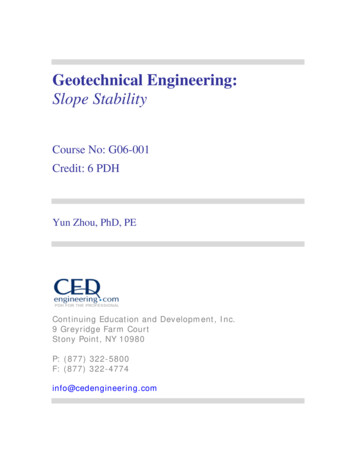
Transcription
Geotechnical Engineering:Slope StabilityCourse No: G06-001Credit: 6 PDHYun Zhou, PhD, PEContinuing Education and Development, Inc.9 Greyridge Farm CourtStony Point, NY 10980P: (877) 322-5800F: (877) 322-4774info@cedengineering.com
U.S. Department of TransportationFederal Highway AdministrationPublication No. FHWA NHI-06-088December 2006NHI Course No. 132012SOILS AND FOUNDATIONSReference Manual – Volume ITestingTheoryExperienceNational Highway Institute
Technical Report Documentation Page1. Report No.2. Government Accession No.3. Recipient’s Catalog No.FHWA-NHI–06-0884. Title and Subtitle5. Report DateDecember 2006SOILS AND FOUNDATIONS6. Performing Organization CodeREFERENCE MANUAL – Volume I7. Author(s)8. Performing Organization Report No.Naresh C. Samtani*, PE, PhD and Edward A. Nowatzki*, PE, PhD9. Performing Organization Name and Address10. Work Unit No. (TRAIS)Ryan R. Berg and Associates, Inc.2190 Leyland Alcove, Woodbury, MN 55125* NCS GeoResources, LLC640 W Paseo Rio Grande, Tucson, AZ 8573711. Contract or Grant No.12. Sponsoring Agency Name and Address13. Type of Report and Period CoveredNational Highway InstituteU.S. Department of TransportationFederal Highway Administration, Washington, D.C. 2059014. Sponsoring Agency CodeDTFH-61-02-T-6301615. Supplementary NotesFHWA COTR – Larry JonesFHWA Technical Review –Jerry A. DiMaggio, PE; Silas Nichols, PE; Richard Cheney, PE;Benjamin Rivers, PE; Justin Henwood, PE.Contractor Technical Review – Ryan R. Berg, PE; Robert C. Bachus, PhD, PE;Barry R. Christopher, PhD, PEThis manual is an update of the 3rd Edition prepared by Parsons Brinckerhoff Quade & Douglas, Inc, in 2000.Author: Richard Cheney, PE. The authors of the 1st and 2nd editions prepared by the FHWA in 1982 and 1993,respectively, were Richard Cheney, PE and Ronald Chassie, PE.16. AbstractThe Reference Manual for Soils and Foundations course is intended for design and construction professionals involvedwith the selection, design and construction of geotechnical features for surface transportation facilities. The manual isgeared towards practitioners who routinely deal with soils and foundations issues but who may have little theoreticalbackground in soil mechanics or foundation engineering. The manual’s content follows a project-oriented approachwhere the geotechnical aspects of a project are traced from preparation of the boring request through designcomputation of settlement, allowable footing pressure, etc., to the construction of approach embankments andfoundations. Appendix A includes an example bridge project where such an approach is demonstrated.Recommendations are presented on how to layout borings efficiently, how to minimize approach embankmentsettlement, how to design the most cost-effective pier and abutment foundations, and how to transmit designinformation properly through plans, specifications, and/or contact with the project engineer so that the project can beconstructed efficiently.The objective of this manual is to present recommended methods for the safe, cost-effective design and construction ofgeotechnical features. Coordination between geotechnical specialists and project team members at all phases of aproject is stressed. Readers are encouraged to develop an appreciation of geotechnical activities in all project phasesthat influence or are influenced by their work.17. Key Words18. Distribution StatementSubsurface exploration, testing, slope stability, embankments, cut slopes, shallowfoundations, driven piles, drilled shafts, earth retaining structures, construction.19. Security Classif. (of this report)UNCLASSIFIEDForm DOT F 1700.7(8-72)20. Security Classif. (of this page)UNCLASSIFIEDReproduction of completed page authorizedNo restrictions.21. No. of Pages46222. Price
CHAPTER 6.0SLOPE STABILITYGround stability must be assured prior to consideration of other foundation related items.Embankment foundation problems involve the support of the embankment by natural soil.Problems with embankments and structures occasionally occur that could be prevented byinitial recognition of the problem and appropriate design. Stability problems most oftenoccur when the embankment is to be built over soft soils such as low strength clays, silts, orpeats. Once the soil profile, soil strengths, and depth of ground water table have beendetermined by field explorations and/or field and laboratory testing, the stability of theembankment can be analyzed and a factor of safety estimated. If the embankment is found tobe unstable, measures can then be taken to stabilize the foundation soils.As illustrated in Figure 6-1, there are four major types of instability that should be consideredin the design of embankments over weak foundation soils. Recommendations on how torecognize, analyze, and solve each of the first three problems are presented in this chapter.Lateral squeeze is more closely related to the evaluation of foundation deformation and isdiscussed in Chapter 7 (Approach Roadway Deformations).The stability problems illustrated in Figure 6-1 can be classified as “internal” or "external.""Internal" embankment stability problems generally result from the selection of poor qualityembankment materials and/or improper placement of the embankment fills and/or improperplacement requirements. The infinite slope failure mode is an example of an “internal”stability problem; often such a failure is manifested as sloughing of the surface of the slope.Internal stability can be assured through project specifications by requiring granular materialswith minimum gradation and compaction requirements. An example of a typicalspecification for approach roadway construction is presented in Chapter 7. The failuremodes shown in Figure 6-1b, c and d, can be classified as “external” stability problems.6.01 Primary ReferenceThe primary reference for this chapter is as follows:FHWA (2001a). Soil Slope and Embankment Design Reference Manual. Report No. FHWANHI-01-026, Authors: Collin, J. G., Hung, J. C., Lee, W. S., Munfakh, G., Federal HighwayAdministration, U.S. Department of Transportation.FHWA NHI-06-088Soils and Foundations – Volume I6-16 – Slope StabilityDecember 2006
Shallow translational failure(Infinite Slope condition)Embankment FillFirm Soil(a)(b)(c)(d)Figure 6-1. Embankment failures: (a) Infinite slope failure in embankment fill, (b)Circular arc failure in embankment fill and foundation soil, (c) Sliding block failure inembankment fill and foundation soil, and (d) Lateral squeeze of foundation soil.FHWA NHI-06-088Soils and Foundations – Volume I6-26 – Slope StabilityDecember 2006
6.1EFFECTS OF WATER ON SLOPE STABILITYVery soft, saturated foundation soils or ground water generally play a prominent role ingeotechnical failures in general. They are certainly major factors in cut slope stability and inthe stability of fill slopes involving both “internal” and “external” slope failures. The effectof water on cut and fill slope stability is briefly discussed below. Importance of WaterNext to gravity, water is the most important factor in slope stability. The effect ofgravity is known, therefore, water is the key factor in assessing slope stability. Effect of Water on Cohesionless SoilsIn cohesionless soils, water does not affect the angle of internal friction (φ). The effectof water on cohesionless soils below the water table is to decrease the intergranular(effective) stress between soil grains (σ'n), which decreases the frictional shearingresistance (τ'). Effect of Water on Cohesive SoilsRoutine seasonal fluctuations in the ground water table do not usually influence eitherthe amount of water in the pore spaces between soil grains or the cohesion. Theattractive forces between soil particles prevent water absorption unless external forcessuch as pile driving, disrupt the grain structure. However, certain clay minerals do reactto the presence of water and cause volume changes of the clay mass.An increase in absorbed moisture is a major factor in the decrease in strength ofcohesive soils as shown schematically in Figure 6-2. Water absorbed by clay mineralscauses increased water contents that decrease the cohesion of clayey soils. These effectsare amplified if the clay mineral happens to be expansive, e.g., montmorillonite.FHWA NHI-06-088Soils and Foundations – Volume I6-36 – Slope StabilityDecember 2006
CohesiveStrengthWaterContentFigure 6-2. Effect of water content on cohesive strength of clay. Fills on ClaysExcess pore water pressures are created when fills are placed on clay or silt. Providedthe applied loads do not cause the undrained shear strength of the clay or silt to beexceeded, as the excess pore water pressure dissipates consolidation occurs, and theshear strength of the clay or silt increases with time. For this reason, the factor of safetyincreases with time under the load of the fill. Cuts in ClayAs a cut is made in clay the effective stress is reduced. This reduction will allow theclay to expand and absorb water, which will lead to a decrease in the clay strength withtime. For this reason, the factor of safety of a cut slope in clay may decrease with time.Cut slopes in clay should be designed by using effective strength parameters and theeffective stresses that will exist in the soil after the cut is made. Slaking - Shales, Claystones, Siltstones, etc.Sudden moisture increase in weak rocks can produce a pore pressure increase in trappedpore air accompanied by local expansion and strength decrease. The "slaking" orsudden disintegration of hard shales, claystones, and siltstones results from thismechanism. If placed as rock fill, these materials will tend to disintegrate into a claysoil if water is allowed to percolate through the fill. This transformation from rock toclay often leads to settlement and/or shear failure of the fill. Index tests such as the jarslake test and the slake-durability test used to assess slaking potential are discussed inFHWA (1978).FHWA NHI-06-088Soils and Foundations – Volume I6-46 – Slope StabilityDecember 2006
6.2DESIGN FACTOR OF SAFETYA minimum factor of safety as low as 1.25 is used for highway embankment side slopes.This value of the safety factor should be increased to a minimum of 1.30 to 1.50 for slopeswhose failure would cause significant damage such as end slopes beneath bridge abutments,major retaining structures and major roadways such as regional routes, interstates, etc Theselection of the design safety factor for a particular project depends on: The method of stability analysis used (see Section 6.4.5). The method used to determine the shear strength. The degree of confidence in the reliability of subsurface data. The consequences of a failure. How critical the application is.6.3INFINITE SLOPE ANALYSISA slope that extends for a relatively long distance and has a consistent subsurface profile maybe analyzed as an infinite slope. The failure plane for this case is parallel to the surface ofthe slope and the limit equilibrium method can be applied readily.6.3.1Infinite Slopes in Dry Cohesionless SoilsA typical section or “slice” through the potential failure zone of a slope in a dry cohesionlesssoil, e.g., dry sand, is shown in Figure 6-3, along with its free body diagram. The weight ofthe slice of width b and height h having a unit dimension into the page is given by:W γbh6-1where γ is the effective unit weight of the dry soil. For a slope with angle β as shown inFigure 6-3, the normal (N) and tangential (T) force components of W are determined asfollows:N W cos β andT W sin βFHWA NHI-06-088Soils and Foundations – Volume I6-56-26-36 – Slope StabilityDecember 2006
βbSSlopeSurfaceWhNNTβWSForce PolygonNFailureSurfaceFigure 6-3. Infinite slope failure in dry sand.The available shear strength along the failure plane is given by:S N tan φ6-4The factor of safety (FS) is defined as the ratio of available shear strength to strengthrequired to maintain stability. Thus, the FS will be given by:FS tan φSN tan φ (W cos β) tan φ T W sin βW sin βtan β6-5For an infinite slope analysis, the FS is independent of the slope depth, h, and depends onlyon the angle of internal friction, φ, and the angle of the slope, β. The slope is said to havereached limit equilibrium when FS 1.0. Also, at a FS 1.0, the maximum slope angle willbe limited to the angle of internal friction, φ.6.3.2Infinite Slopes in c-φ Soils with Parallel SeepageIf a saturated slope in a c-φ soil has seepage parallel to the surface of the slope as shown inFigure 6-4, the same limit equilibrium concepts may be applied to determine the FS, whichwill now depend on the effective normal force (N'). In the following analysis, effective shearstrength parameters, c' and φ' are used.FHWA NHI-06-088Soils and Foundations – Volume I6-66 – Slope StabilityDecember 2006
Slope SurfaceβSeepage FlowhbWhh cos2βTN' UPore Water ForceU γwbh cosβFailure SurfaceFigure 6-4. Infinite slope failure in a c-φ soil with parallel seepage.From Figure 6-4, the pore water force acting on the base of a typical slice having a unitdimension into the page is:U ( γ w h cos 2 β ) cosb β γ w b h cos β6-6where h is any depth less than or equal to the depth of saturation and b is a unit width.The available frictional strength, S, along the failure plane will depend on φ' and the effectivenormal force, N' N-U, where N is the total normal force. The equation for S is:S c'b ( N - U ) tan φ'cos β6-7The factor of safety for this case will be:FS S(c' b/cos β ) ( N - U ) tan φ ' TW sin β6-8By substituting W γsat b h into the above expression and rearranging terms, the FS is givenby:FHWA NHI-06-088Soils and Foundations – Volume I6-76 – Slope StabilityDecember 2006
FS c' h ( γsat - γ w ) (cos 2 β) tan φ'γsat h sin β cos β6-9where γ' (γsat - γw).For c' 0, the above expression may be simplified to:FS γ ' tan φ'γsat tan β6-10From Equation 6-10 it is apparent that for a cohesionless material with parallel seepage, theFS
6.3 INFINITE SLOPE ANALYSIS A slope that extends for a relatively long distance and has a consistent subsurface profile may be analyzed as an infinite slope. The failure plane for this case is parallel to the surface of the slope and the limit equilibrium method can be applied readily. 6.3.1 Infinite Slopes in Dry Cohesionless SoilsFile Size: 1MBPage Count: 62Explore further11. THE STABILITY OF SLOPESpeople.eng.unimelb.edu.auLecture 12: Slope Stabilitykula.geol.wwu.eduNotes on Topic 2 - Slope Stability - StuDocuwww.studocu.comRecommended to you based on what's popular Feedback

